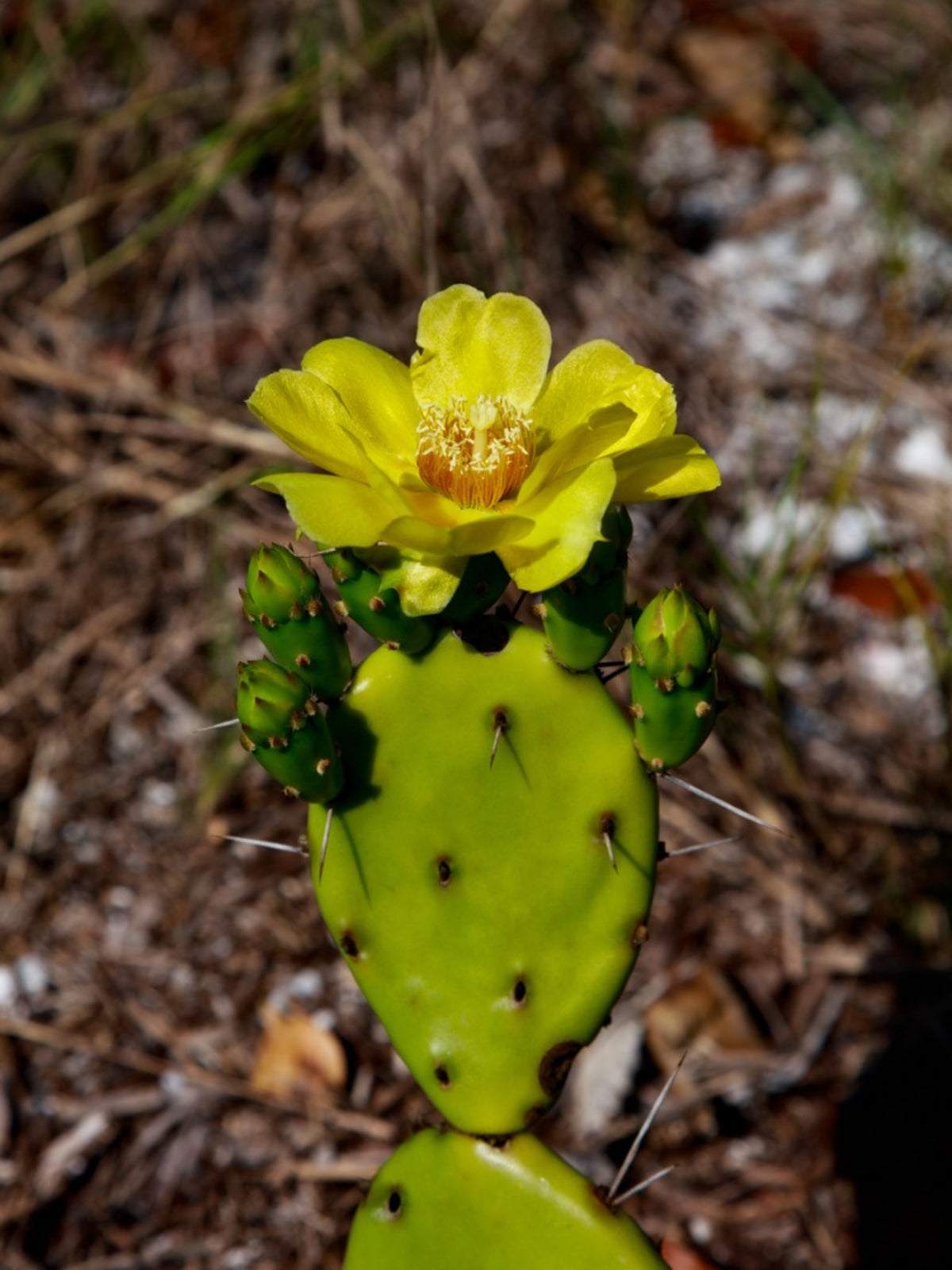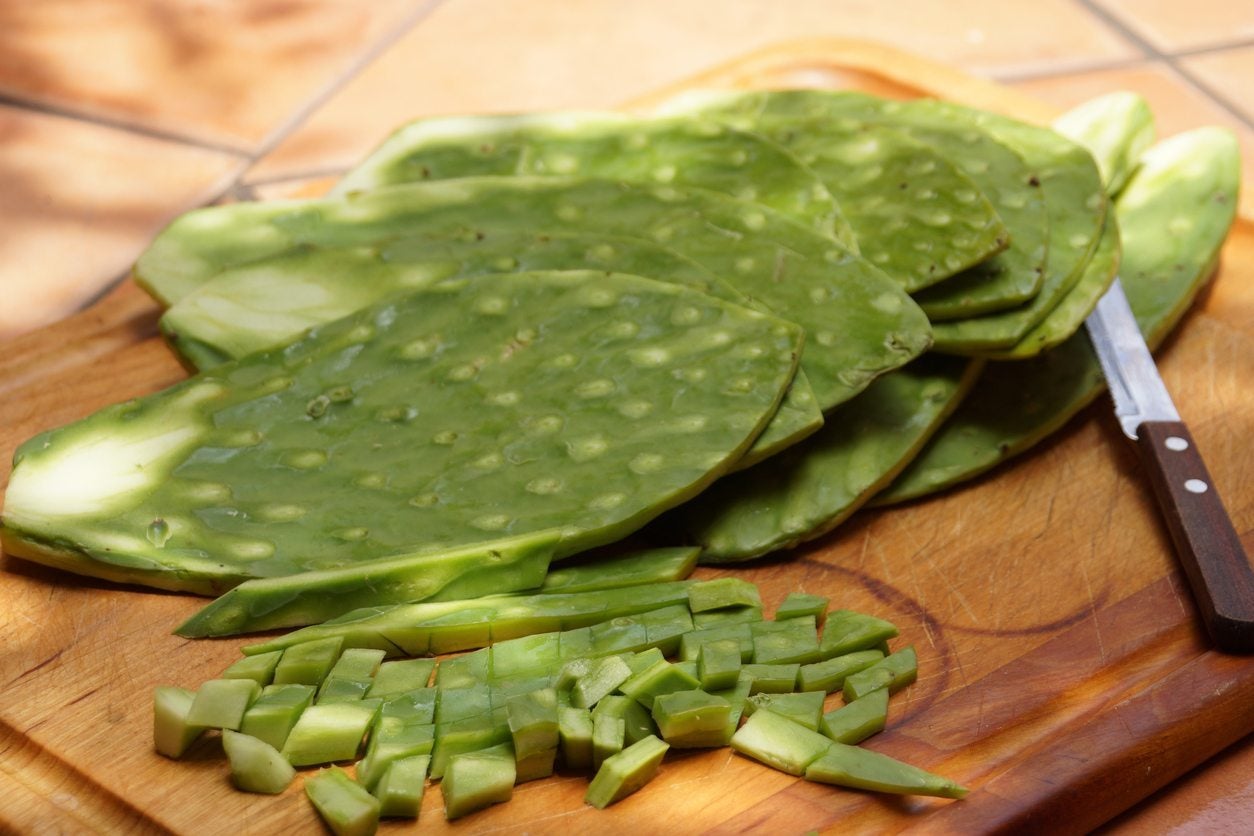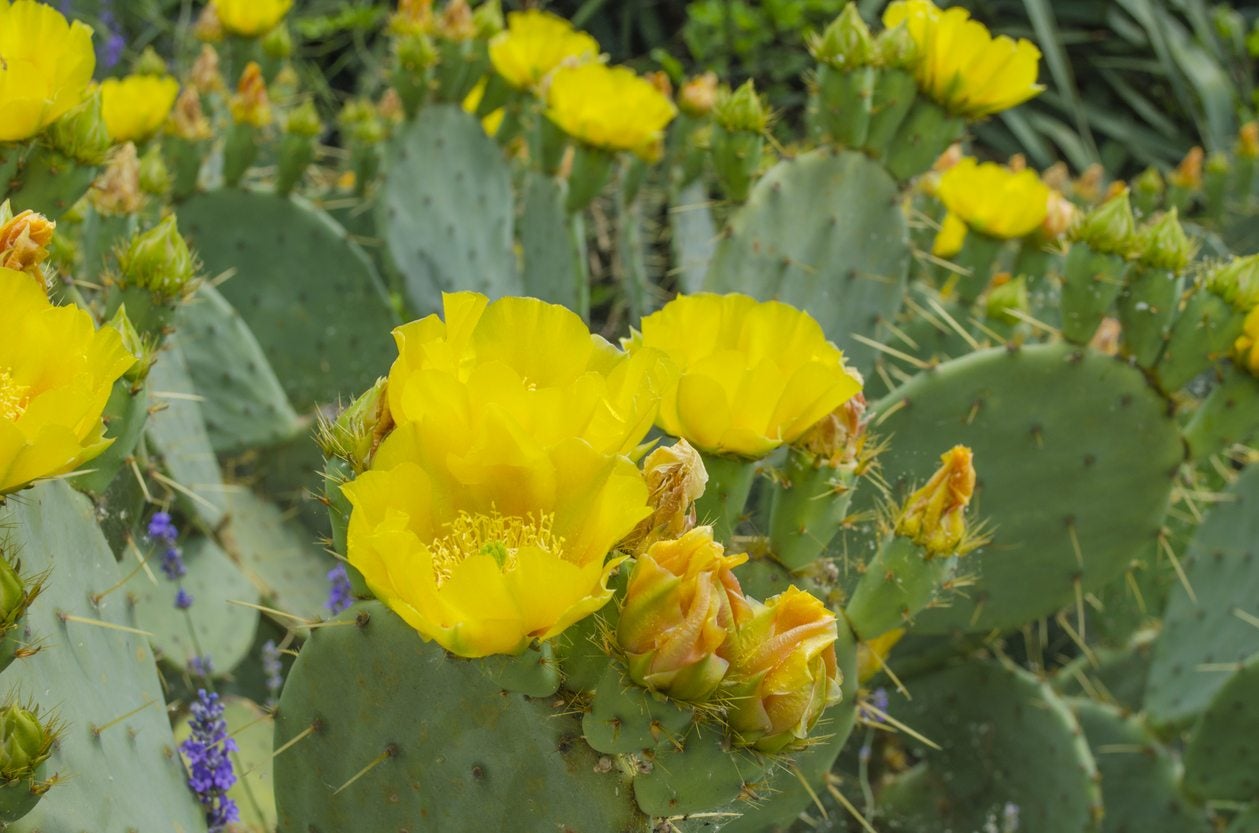Growing Cold Hardy Eastern Prickly Pear Cactus


The cold hardy prickly pear cactus (Opuntia humifusa) is beautiful, providing showy yellow blooms in June and July in the landscape where they’ve naturalized. The Opuntia humifusa flower sometimes has a red eye, making them even more striking. Flowers may even bloom red or orange. Each bloom lasts just a day, but the plant continues to blossom for weeks.
Cold Hardy Prickly Pears
When flowers fade, the plant produces tunas, a semi-sweet and juicy fruit. These are popular and collected on a large scale worldwide. They’re used in jams, chutney, or cactus pear jelly.
This cactus family member grows primarily in the eastern area of the U.S., hardy in USDA zones 4 through 9. Opuntia humifusa originated in the northeastern plains of the U.S., although the plant is said to be rare in many areas. Common names include Indian fig, the devil's-tongue, or the eastern prickly pear. It is attractive to pollinators and attracts gopher tortoises.
The prickly pear was listed in older information as Opuntia compressa. 150 species exist in the Opuntia family. Eastern prickly pear is considered an aged group within this family. This cactus has the widest range of growth of any cacti native to the U.S. Other than the eastern area mentioned above, it is found in New Mexico, Montana, Florida, Massachusetts, and many areas in between. It may also be found growing in Ontario, Canada.
This spreading beauty reaches 1.5 feet tall by 3 feet wide (46 x 91 cm.) as it develops into colonies. Plants may also grow individually. It is sometimes considered a shrub. It has short and spreading fibrous roots that develop from any pad that is broken off.
The pads of this plant, called nopales, are considered the stems, with the spikes that cover them thought of as leaves. Spikes protect the plant from munching wild animals. Pads hold water which allows the cactus to exist well in dry areas. Nopales are edible and used in lots of Mexican cuisines. Keep in mind that areas that are too moist cause problems when growing this plant.
How to Grow Eastern Prickly Pear
These grow easily in colder areas in gravelly or sandy soil and any other soil that drains well, so long as it is in full sun. Prickly pear prefers a soil pH of 6 to 7. The eastern prickly pear range includes areas with clay soil too. Devil’s tongue will grow in sunny clay where good drainage is established, as long as the soil does not remain wet. Don’t plant in rich soil as it will cause growth too quickly, which may result in pest and disease issues.
Gardening tips, videos, info and more delivered right to your inbox!
Sign up for the Gardening Know How newsletter today and receive a free copy of our e-book "How to Grow Delicious Tomatoes".
Propagate prickly pear from cuttings, if you wish, from the previous year’s pads. Allow them to dry for a week and plant them, cut side down, into the garden or a container—being careful of the spines. Thick leather gloves are somewhat helpful against the spines. Use tongs. Plant in containers to keep them closer to the home. Use caution if children or pets will be in the area.

Becca Badgett was a regular contributor to Gardening Know How for ten years. Co-author of the book How to Grow an EMERGENCY Garden, Becca specializes in succulent and cactus gardening.
-
 12 Lush Alternatives To A Lawn For Sustainable Spaces
12 Lush Alternatives To A Lawn For Sustainable SpacesAlternatives to a lawn are beautiful and also beneficial to your local ecosystem and its pollinators. Explore our top picks for plants to replace grass.
By Tonya Barnett
-
 Types Of Tomatoes Explained: Explore The Many Wonderful Shapes, Colors, Flavors, & Best Uses
Types Of Tomatoes Explained: Explore The Many Wonderful Shapes, Colors, Flavors, & Best UsesThe world of tomato varieties is vast and fascinating. Learn about the key types to grow in your garden, tailored to your preferences and space.
By Amy Grant
-
 Spineless Prickly Pear Info – Tips For Growing Ellisiana Prickly Pears
Spineless Prickly Pear Info – Tips For Growing Ellisiana Prickly PearsIf you are among the many gardeners who like cactus but don’t like spines, it may be time to consider installing ellisiana cactus in your backyard, better known as spineless prickly pear. Click here for information on growing ellisiana prickly pear.
By Teo Spengler
-
 Engelmann Prickly Pear Info – Learn About Growing Cactus Apple Plants
Engelmann Prickly Pear Info – Learn About Growing Cactus Apple PlantsEngelmann prickly pear, also commonly called cactus apple plants, is a wide-ranging species of prickly pear. This is a pretty plant for desert gardens, and it will grow at a moderate rate to fill in large spaces. Learn more about it in this article.
By Mary Ellen Ellis
-
 Cow’s Tongue Plant Care: How To Grow A Prickly Pear Cow’s Tongue
Cow’s Tongue Plant Care: How To Grow A Prickly Pear Cow’s TongueFolks that live in hot climates often utilize plants that are drought tolerant. A great example is a cow’s tongue prickly pear. Besides having a fabulous tongue in cheek name, it is very tolerant of heat and dry conditions, plus it makes a great barrier. Learn more here.
By Amy Grant
-
 Beavertail Cactus Care – How To Grow A Beavertail Prickly Pear Cactus
Beavertail Cactus Care – How To Grow A Beavertail Prickly Pear CactusBeavertail prickly pear cactus is a clumping, spreading cactus with flat, grayish-green, paddle-like leaves. It glows with brilliant, rose-purple blooms in spring and early summer. Have we piqued your curiosity? Click here for more beavertail prickly pear information.
By Mary H. Dyer
-
 Tulip Prickly Pear Info: Guide To Growing Brown Spined Prickly Pears
Tulip Prickly Pear Info: Guide To Growing Brown Spined Prickly PearsWhat is a tulip prickly pear? This cactus is also known as brown spined prickly pear for its rust to reddish brown spines. If you live in warm, arid regions, learn how to grow brown spined prickly pear and add its unique flowers to your garden. This article will help.
By Bonnie L. Grant
-
 Harvesting Edible Cactus Pads – How To Pick Cactus Pads To Eat
Harvesting Edible Cactus Pads – How To Pick Cactus Pads To EatOpuntia produces several types of edibles. The fruits are delicious in jams and jellies. But can you eat cactus pads? Yes, the broad, succulent pads can be eaten raw or cooked. You just need to know how to pick cactus pads and how to prepare them. This article will help.
By Bonnie L. Grant
-
 Opuntia Barbary Fig Info: How To Grow A Barbary Fig Plant
Opuntia Barbary Fig Info: How To Grow A Barbary Fig PlantOpuntia ficus-indica is more commonly known as a Barbary fig, a variety of prickly pear cactus. This desert plant has been used for centuries as food, fending, and even dye. Growing Barbary fig plants is both rewarding and useful. Learn more in this article.
By Mary Ellen Ellis
-
 Opuntia Cactus Varieties: What Are Different Types Of Opuntia Cactus
Opuntia Cactus Varieties: What Are Different Types Of Opuntia CactusOpuntia is the largest genus in the cactus family. You will recognize most by their classic "prickly pear" appearance. Growing Opuntia in gardens adds desert appeal and unique flora to the landscape. Learn more about the plants in this article.
By Bonnie L. Grant